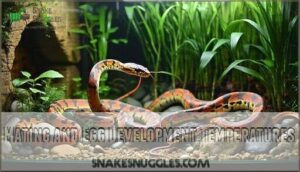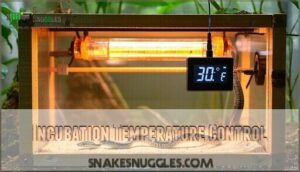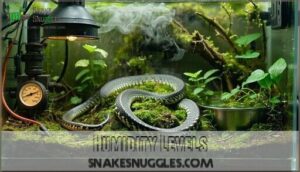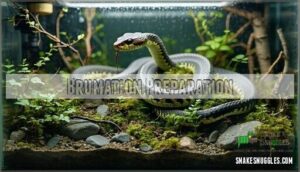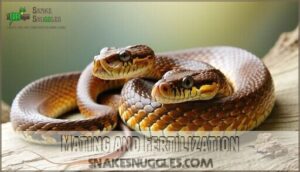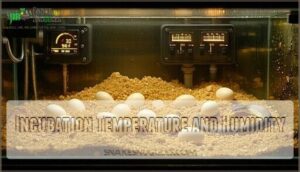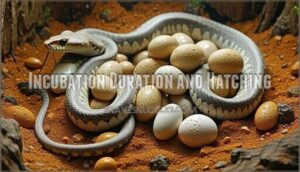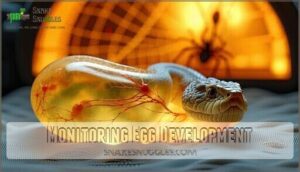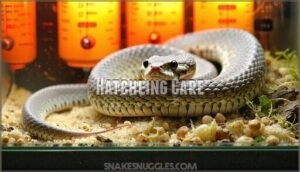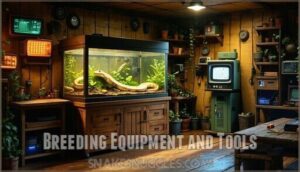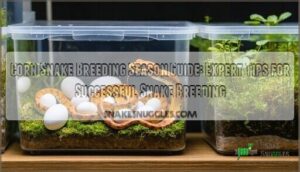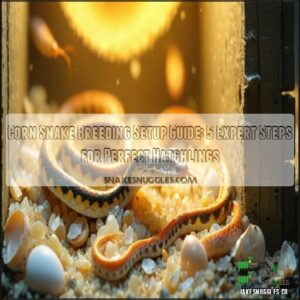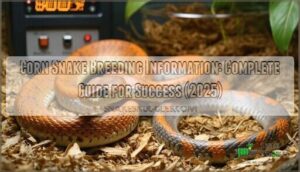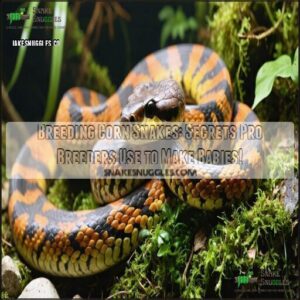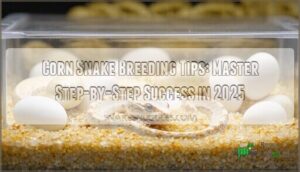This site is supported by our readers. We may earn a commission, at no cost to you, if you purchase through links.
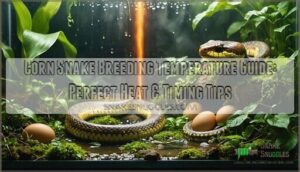
After this cooling period, you’ll want to gradually warm your snakes to 78-82°F for ideal mating conditions.
Once eggs are laid, maintaining incubation temperatures between 82-84°F guarantees proper embryonic development—even a few degrees off can spell trouble for hatch rates.
Don’t forget humidity levels of 80-90% during incubation. Getting these temperatures dialed in perfectly separates successful breeders from those left scratching their heads over empty clutches.
Table Of Contents
- Key Takeaways
- Breeding Season Timing
- Temperature Management
- Humidity Levels
- Brumation Preparation
- Mating and Fertilization
- Egg Incubation
- Hatchling Care
- Breeding Ethics and Considerations
- Breeding Equipment and Tools
- Frequently Asked Questions (FAQs)
- What temperature to incubate corn snake eggs?
- What month do corn snakes breed?
- What temperature is too cold for a corn snake?
- What temperature does a baby corn snake need?
- What temperature fluctuations are acceptable during incubation?
- How do seasonal room temperatures affect breeding?
- When should I adjust enclosure temperatures post-mating?
- What backup heating methods work during power outages?
- How does altitude impact corn snake temperature requirements?
- Conclusion
Key Takeaways
- Master precise temperature phases – You’ll need 50-60°F for 8-12 weeks during brumation, 75-85°F for mating, and 82-84°F for egg incubation to trigger proper reproductive hormones and development
- Don’t rush the brumation process – You can’t shortcut the 60-90 day cooling period, as shorter brumation often results in poor breeding outcomes and failed reproductive cycles
- Maintain strict temperature stability – You’ll want fluctuations within ±2°F during incubation, since wild temperature swings cause developmental issues, spinal kinking, or complete clutch failure
- Combine temperature with humidity control – You’ll need 80-90% humidity during incubation, alongside proper temperatures, as both factors work together to prevent egg dehydration and ensure healthy hatchlings
Breeding Season Timing
Getting your corn snake’s breeding timing right starts with understanding their natural reproductive cycle.
You’ll need to provide an 8-12 week brumation period at 50-60°F, followed by gradual warming and photoperiod increases to trigger their mating instincts in spring.
Triggering Mating Readiness
Your snake’s reproductive hormones won’t activate without proper environmental triggers.
Winter triggers nature’s breeding switch—no shortcuts to reproductive success.
Temperature cues and photoperiod control work together during brumation prep to simulate natural seasonal changes.
Start with 9-10 hours of light daily, then gradually increase as temperatures rise from 55-60°F to breeding range.
These mating triggers create the perfect corn snake breeding temperature conditions for successful reproduction.
Brumation Length and Impact
Your corn snake’s brumation timing directly impacts reproductive success.
Plan for 60-90 days of winter simulation at 55-60°F to trigger reproductive readiness.
This cooling period can’t be rushed—shorter brumation often results in poor breeding outcomes.
Temperature control during this extended timeframe activates hormonal changes necessary for successful corn snake breeding temperature management and ideal incubation temperature conditions later.
Photoperiod Manipulation
Beyond simple temperature control, photoperiod manipulation serves as your secret weapon for triggering corn snake breeding hormones.
Light cycles directly influence circadian rhythms, making day length adjustments vital for successful seasonal triggers.
Here’s your photoperiod breeding strategy:
- Winter simulation: Start with 9-10 hours of light during brumation
- Spring shift: Gradually increase to 12-14 hours over 4-6 weeks
- Breeding peak: Maintain 14+ hours during active mating season
This reptile photoperiod mimics natural hormone regulation patterns that wild corn snakes experience.
Temperature Management
Temperature control determines your breeding success more than any other factor.
Temperature control is the make-or-break factor that separates successful breeders from heartbroken hobbyists.
You’ll need precise ranges for each phase: 50-60°F during brumation, 75-85°F for mating, and 80-85°F for incubation.
Brumation Temperature Range
Precision matters when implementing cooling techniques for successful brumation.
Target 55°F as your sweet spot, staying within the 41-59°F range to avoid health risks.
Temperature control systems should gradually reduce heat over 7-14 days, preventing shock.
Monitor your reptile temperature guide closely—fluctuations below 40°F threaten survival, while exceeding 60°F disrupts winter simulation and depletes vital fat reserves.
Understanding brumation health is essential for maintaining ideal conditions during this period, ensuring the reptile’s overall health risks are minimized.
Mating and Egg Development Temperatures
After brumation, you’ll need to gradually warm your breeding pairs to trigger their reproductive instincts.
Here’s your temperature roadmap for successful mating and egg development:
- Mating temperatures: Maintain 75-85°F (24-29°C) to activate courtship behaviors and mating cues
- Egg development phase: Keep females at 80-84°F (27-29°C) for ideal follicle growth
- Pre-laying conditions: Provide stable 82-85°F (28-29°C) warm zones near nesting sites
Temperature drops below 70°F can delay mating, while excessive heat above 89°F causes reproductive stress.
Proper reproductive hormone regulation is vital for successful breeding outcomes.
Incubation Temperature Control
Digital thermostats maintain ideal incubation temperature between 80-84°F with precise calibration.
Temperature stability prevents developmental issues—fluctuations beyond 2°F can cause kinking or deformities.
Quality heat sources paired with backup humidity sensors guarantee consistent reptile incubation success.
Monitor temperature control daily using reliable equipment to achieve healthy hatching rates in your snake breeding temperature setup.
Maintaining proper temperature control systems is vital for successful snake egg incubation, ensuring healthy hatching rates, and requires precise calibration, and consistent reptile incubation success.
Humidity Levels
Humidity control proves just as critical as temperature for successful corn snake breeding cycles.
You’ll need to maintain specific humidity ranges during different phases – from routine breeding conditions to the specialized requirements of egg incubation.
Routine Breeding Humidity
You’ll maintain humidity levels between 50-60% during routine breeding periods.
This moisture control supports healthy shedding cycles and respiratory function without creating excessive dampness that encourages bacterial growth.
Your humidity management checklist includes:
- Daily monitoring – Check levels twice using digital hygrometers
- Water bowl placement – Position near warm side for natural evaporation
- Ventilation balance – Guarantee air quality while retaining moisture
- Substrate selection – Use materials that regulate humidity naturally
Proper reptile enclosure humidity prevents stress-related breeding complications while maintaining comfortable conditions for both males and females throughout the mating season.
Incubation Humidity Requirements
When eggs reach their incubation phase, you’ll need to crank up humidity levels to 80-90% – think tropical rainforest conditions.
This moisture boost supports proper egg development by preventing dehydration and maintaining flexible shells.
Your incubator setup should include damp vermiculite or perlite substrate for consistent humidity control.
Monitor levels daily with a reliable hygrometer, as fluctuations can spell disaster for developing embryos, requiring careful management to prevent dehydration.
Maintaining Optimal Humidity
Several key factors work together to maintain proper humidity levels during corn snake breeding. You’ll want to monitor moisture levels with calibrated hygrometers, use misting systems for daily moisture boosts, and provide humid hides filled with damp sphagnum moss.
Fogging systems help maintain consistent humidity maintenance overnight, while proper water management prevents dangerous fluctuations that stress breeding pairs.
Maintaining ideal humidity involves understanding safe snake shedding humidity levels, which is vital for proper humidity control, and this knowledge is crucial for successful corn snake breeding.
Brumation Preparation
Proper brumation preparation sets the foundation for successful corn snake breeding by mimicking natural winter conditions that trigger reproductive hormones.
You’ll need to establish precise cooling protocols and verify your snakes are physiologically ready for this critical 60-90 day period, which is essential for successful breeding.
Cooling Period Duration
Getting your cooling period duration right makes or breaks successful corn snake breeding.
During winter simulation, you’ll need precise brumation timing to trigger those vital reproductive hormones that guarantee healthy offspring.
Here’s your temperature guide for the cool period:
- Duration: 60-75 days of consistent cooling between December and February
- Temperature range: Maintain 45-65°F throughout the entire chill duration
- Monitoring: Check temperatures daily – fluctuations above 65°F deplete fat reserves
- Consistency: Avoid temperature drops below 45°F which can stress your snakes
This hibernation period activates the biological switches your corn snakes need for successful breeding season ahead.
Digestive Clearance Before Brumation
Stop feeding your snake 2-3 weeks before starting brumation to guarantee complete digestive clearance.
This Pre Brumation Diet withdrawal prevents food rot during the cool period.
Watch for defecation to confirm Gut Clearance before beginning Temperature Acclimation.
Proper Food Withdrawal timing supports safe snake breeding temperature shifts and successful brumation outcomes.
Monitoring Health During Brumation
After digestive clearance, you’ll need to keep a watchful eye on your snakes throughout brumation. Temperature monitoring becomes your best friend during this critical period.
Regular health checks confirm your breeding program stays on track. Here’s your monitoring checklist:
- Weekly Weight Checks – Track gradual weight loss; sudden drops signal health issues requiring immediate veterinary care
- Temperature Verification – Use digital thermometers to confirm 55-60°F range; fluctuations stress snakes and compromise breeding success
- Visual Health Inspections – Check for mites, retained sheds, or respiratory symptoms; healthy snakes remain alert despite reduced activity
Snake health during brumation depends on consistent reptile husbandry tips and proper breeding ethics. Understanding brumation care techniques is vital for a successful breeding program.
Mating and Fertilization
Once your snakes emerge from brumation and begin their warming period, you’ll notice distinct behavioral changes that signal readiness for reproduction.
Males become increasingly active and will seek out females through pheromone recognition, while females display receptive behaviors when temperatures reach the ideal 75-85°F range, which is a key factor in their reproduction.
Mating Cues and Behaviors
After brumation ends, you’ll notice your snakes becoming more active as breeding triggers kick in.
Males display courtship behaviors like following females and tongue-flicking to detect pheromone signals.
Watch for cloacal alignment attempts during mating cues.
Successful sperm transfer involves tail intertwining duration of 10-20 minutes, with males positioning hemipenes for fertilization.
Egg Development and Laying
After successful mating, you’ll notice egg formation beginning within your female corn snake’s body. Fertilization occurs internally, and egg development takes approximately 4-6 weeks. During this period, maintain proper incubation temperature ranges to support healthy clutch development.
Key egg development indicators include:
- Physical changes: Enlarged mid-body section and reduced appetite as eggs develop
- Behavioral shifts: Increased basking and seeking darker, more humid nesting sites
- Pre-laying shed: Occurs 1-2 weeks before the laying process begins
Your gravid female will lay 10-30 eggs roughly 30-45 days post-mating. Provide appropriate nesting sites with damp substrate for ideal egg care and successful reproduction.
Egg Incubation
Once you’ve successfully mated your corn snakes, the real precision work begins with egg incubation.
Temperature control during this 55-75 day period determines whether you’ll celebrate healthy hatchlings or face the heartbreak of developmental failures.
Incubation Temperature and Humidity
Once you’ve achieved mating success, proper egg incubation becomes your next priority.
Maintain incubation temperature between 80-84°F for ideal development—temperatures above 86°F risk deformities while below 78°F slows growth.
Keep humidity at 80-90% using damp vermiculite substrate.
Temperature stability prevents developmental defects, so invest in quality monitoring equipment for consistent results.
Incubation Duration and Hatching
Corn snake incubation time spans 55-75 days, depending on your temperature control settings.
Lower incubation temperatures extend development but reduce deformities – it’s like slow-cooking a perfect meal. At 80-82°F, expect hatchlings to emerge around day 60.
The incubation media should stay consistently damp, never soaking wet. Watch for eggs dimpling slightly before hatching begins – nature’s countdown timer for egg development success.
Monitoring Egg Development
Watching eggs like a hawk pays off during the 55-75 day journey.
Egg candling reveals embryo development through translucent shells, showing blood vessels and movement.
Track egg weight changes weekly – healthy eggs gain moisture.
Developmental stages become visible around day 30.
Fetal monitoring helps spot problems early.
Maintain steady incubation temperature and check for dimpling or mold.
Your vigilance guarantees successful hatching in this critical egg development phase of reptile breeding.
Hatchling Care
Once your corn snake eggs successfully hatch after 55-75 days of careful incubation, you’ll need to provide specialized care that mimics their natural environment while supporting rapid early growth.
Proper neonatal temperature gradients and feeding protocols are critical during these first few vulnerable weeks when hatchlings establish their thermoregulation patterns and begin their feeding response, which is essential for their development and involves the establishment of thermoregulation patterns.
Neonatal Enclosure Setup
Proper incubation temperature sets the foundation for healthy hatchlings, but your reptile enclosure setup determines their survival odds.
Create a neonatal heating gradient of 82-86°F warm end and 75-80°F cool zone using under-tank heaters. Select paper towels as hatchling substrate—easy cleaning prevents bacterial growth.
Install low-wattage enclosure lighting for day/night cycles. Your baby snake care starts with secure, escape-proof containers featuring proper ventilation holes.
Maintaining ideal temperatures requires understanding reptile heating systems to guarantee the health and well-being of your corn snakes.
Feeding and Hydration Requirements
Your hatchlings need their first meal within 5-10 days after their first shed.
Start with appropriately sized prey – typically pinkie mice that match the thickest part of the snake’s body.
Fresh water should always be available in shallow dishes to prevent drowning while ensuring proper Snake Hydration and Water Quality for ideal development.
Heat and Humidity Management
After ensuring your hatchlings can feed properly, you’ll need to master their environmental requirements to keep them thriving.
Temperature control and humidity levels work together like dance partners – when one’s off, both suffer.
Your heat sources should maintain a basking temperature of 82-86°F with a cool zone at 75-80°F using a reliable heat mat thermostat.
Ventilation systems prevent stagnant air while humidity control keeps levels at 65-75%.
Monitor your reptile enclosure temperature daily, as thermostat settings can drift over time.
- Watch tiny scales shimmer as perfect humidity prevents painful stuck sheds that could cost fingers or tails
- Feel the relief knowing your temperature gradient lets stressed babies choose their comfort zone instead of overheating
- Sleep peacefully with automated systems maintaining life-supporting conditions while you rest
Breeding Ethics and Considerations
Breeding corn snakes responsibly goes beyond mastering temperatures and timing—it requires careful consideration of animal welfare and genetic health.
You’ll need to evaluate your motivations, guarantee proper care for all offspring, and maintain breeding records to prevent genetic issues that could harm future generations, ensuring the well-being of the snakes through responsible actions.
Responsible Breeding Practices
Ethics matter when breeding snakes responsibly.
You’ll need genetic testing to avoid inbreeding and hereditary defects that compromise snake welfare.
Document your breeding lines painstakingly, maintaining temperature stability throughout the process.
Consider conservation impact—don’t flood markets with unhealthy animals.
Your breeder liability extends beyond sales to lifetime animal welfare.
Responsible corn snake breeding temperature guide practices protect both reptiles and the hobby’s reputation.
Animal Welfare and Conservation
Conservation efforts in corn snake breeding extend beyond your basement setup to support wild populations facing habitat loss.
Ethical breeding practices connect directly to Wildlife Preservation through responsible animal welfare standards.
- Support Snake Sanctuaries by avoiding overbreeding that floods rescue facilities
- Practice reptile welfare by prioritizing snake health over profit margins
- Contribute to conservation efforts through documented breeding records
- Follow Animal Rights guidelines preventing unnecessary stress during breeding cycles
Genetic Health and Diversity
Beyond proper temperatures, genetic health shapes your breeding program’s long-term success.
You’ll minimize inbreeding risks by maintaining detailed lineage records and avoiding sibling pairings. Genetic diversity prevents harmful recessive traits from accumulating across generations.
| Genetic Factor | Risk Level | Prevention Method |
|---|---|---|
| Inbreeding depression | High after 3-7 generations | Outcross every few cycles |
| Stargazing syndrome | Moderate in certain lines | Screen breeding stock |
| Scaleless mutations | Variable by morph | Test parent genetics |
Genetic testing helps identify carriers before breeding. Hybridization effects can introduce unexpected traits, while mutation rates increase with line breeding. Your documentation becomes invaluable for tracking inheritance patterns and maintaining population health.
Breeding Equipment and Tools
You’ll need specific equipment to maintain precise temperatures and humidity throughout the breeding cycle.
Proper tools make the difference between successful clutches and costly mistakes that can harm your snakes or ruin entire breeding seasons, which involves precise temperatures and successful clutches.
Lighting and Temperature Control
You’ll need precise thermal gradients and consistent lighting cycles for successful corn snake breeding.
Digital thermostats prevent dangerous temperature fluctuations while heat mats provide stable warmth.
Set photoperiod timers for 12-hour cycles, adjusting seasonally for breeding.
UVB lighting isn’t required but supports calcium metabolism.
Thermostat calibration guarantees your reptile lighting system maintains ideal temperatures without risking overheating or equipment failure. For enhanced safety, consider a thermostat with overheat protection features.
Humidity Management and Monitoring
You’ll need proper humidity management and monitoring equipment to maintain ideal breeding conditions.
Here’s what works best:
- Misting Techniques: Use pressure sprayers for daily misting with distilled water
- Humid Hide: Provide sphagnum moss hideouts for extra moisture zones
- Ventilation Needs: Install fans to prevent stagnant air while maintaining humidity levels
- Substrate Choice: Select moisture-retentive substrate like cypress mulch or paper towels
Your reptile enclosure humidity should stay between 65-75% during breeding season.
A quality humidifier paired with proper reptile enclosure misting prevents mold prevention issues while supporting healthy shedding cycles. Effective reptile care involves using a reptile humidifier to maintain the ideal environment.
Incubation and Hatching Equipment
Professional incubators provide precise temperature stability essential for successful egg incubation.
You’ll need temperature probes, humidity controllers, and reliable heat mats for your reptile enclosure temperature management.
Digital incubator types with egg turners eliminate manual rotation, while hatching trays catch emerging babies safely.
Invest in quality equipment—your future corn snake hatchlings depend on consistent conditions throughout their development journey.
Reptile breeders often research reptile incubators to find the best equipment for their needs.
Frequently Asked Questions (FAQs)
What temperature to incubate corn snake eggs?
Incubate corn snake eggs at 80-82°F for best results.
This temperature range guarantees proper development while minimizing deformities.
Consistency matters most—temperature fluctuations can cause serious developmental issues in your future hatchlings.
What month do corn snakes breed?
Corn snakes typically breed in April after emerging from brumation.
You’ll trigger their reproductive cycle by warming them from winter cooling periods in March, leading to mating when males shed their skin, which is a complete concept related to their breeding habits.
What temperature is too cold for a corn snake?
Picture your snake’s body temperature plummeting like a thermometer in winter.
Anything below 65°F starts depleting fat reserves, while temperatures under 50°F become dangerously cold and can be fatal for your corn snake.
What temperature does a baby corn snake need?
Baby corn snakes need a temperature gradient of 82-86°F on the warm side and 75-80°F on the cool side.
You’ll want consistent heat to support their rapid growth and proper digestion during those vital first months.
What temperature fluctuations are acceptable during incubation?
You’ll want to keep temperature swings within ±2°F of your target range.
Consistent temperatures between 80-84°F work best—wild fluctuations can cause developmental issues or spinal kinking in your hatchlings, so stability beats perfection.
How do seasonal room temperatures affect breeding?
Seasonal swings substantially sabotage successful corn snake copulation.
You’ll need consistent temperatures during breeding cycles – room fluctuations above 10°F disrupt hormonal triggers, delay mating behaviors, and reduce fertilization rates.
Unless you’re maintaining controlled enclosure environments, fluctuations will negatively impact the breeding process.
When should I adjust enclosure temperatures post-mating?
You’ll need to maintain 75-85°F temperatures immediately after mating for proper egg development.
Keep these breeding temperatures consistent throughout the 4-6 week egg formation period before switching to incubation setup.
What backup heating methods work during power outages?
When winter’s grip loosens on your breeding setup, you’ll need reliable backup heat sources. Use heat packs, propane heaters, or battery-powered ceramic heat emitters to maintain critical temperatures during outages.
How does altitude impact corn snake temperature requirements?
Altitude affects atmospheric pressure, which can impact your corn snake’s thermoregulation slightly.
You’ll need to monitor temperatures more closely and may require slightly higher ambient temps to compensate for reduced air density at elevation.
Conclusion
Successful breeding separates diligent planners from disappointed hobbyists—it’s all about precision.
Your corn snake breeding temperature guide success hinges on consistent monitoring and gradual phases.
Don’t rush the process; each phase demands patience and attention to detail.
Temperature fluctuations can derail months of preparation, so invest in quality equipment and backup systems.
Remember, healthy genetics matter as much as perfect environmental conditions for thriving hatchlings.
- https://www.reptilecymru.co.uk/corn-snake-care-guide/
- https://talis-us.com/blogs/news/optimal-temperature-ranges-for-corn-snakes
- https://www.herps-and-inverts.com/how-to-breed-corn-snakes/
- https://www.fhappliances.com/how-to-incubate-snake-eggs-a-complete-guide/
- https://www.zillarules.com/information/care-sheets/corn-snake


